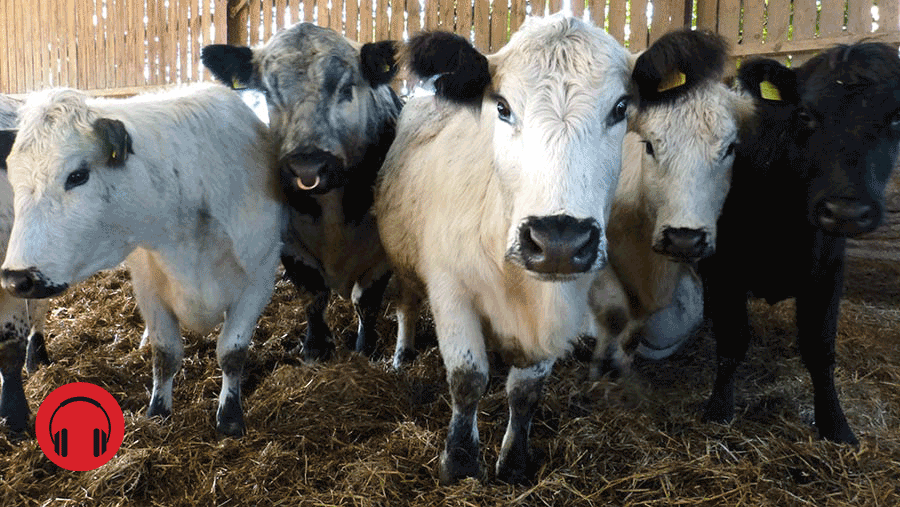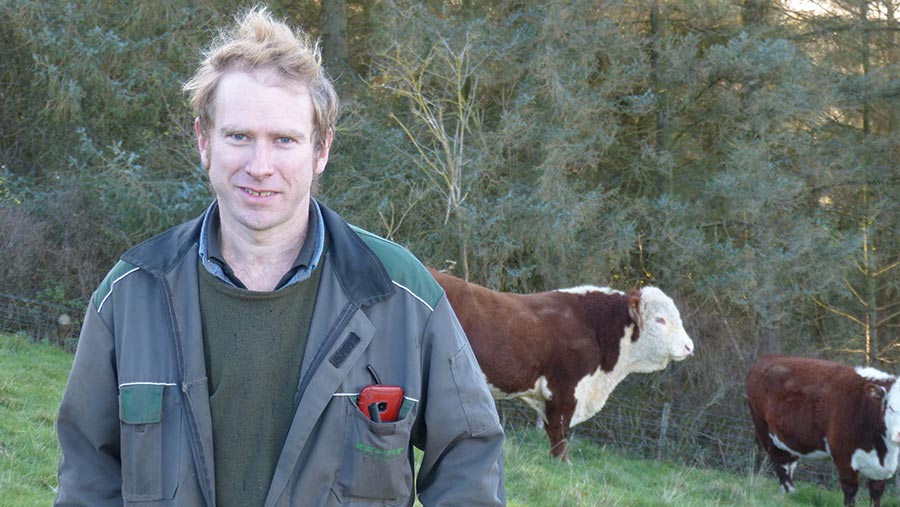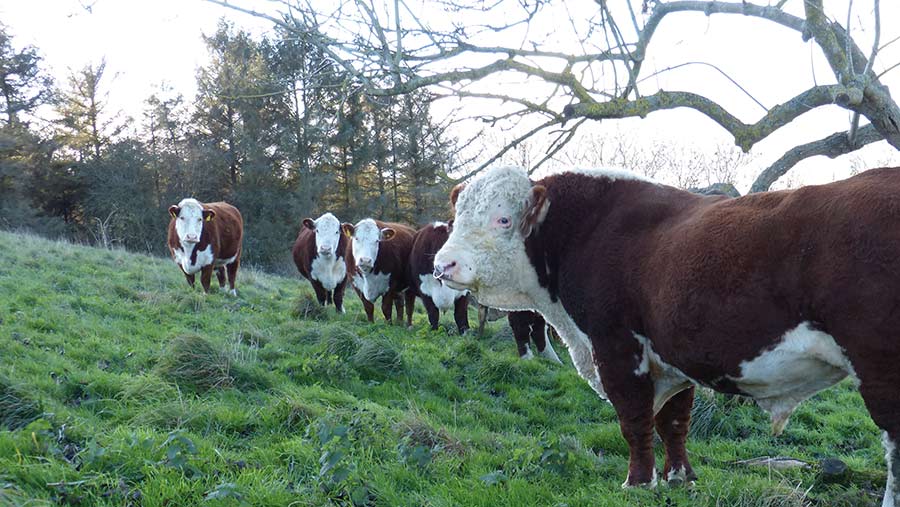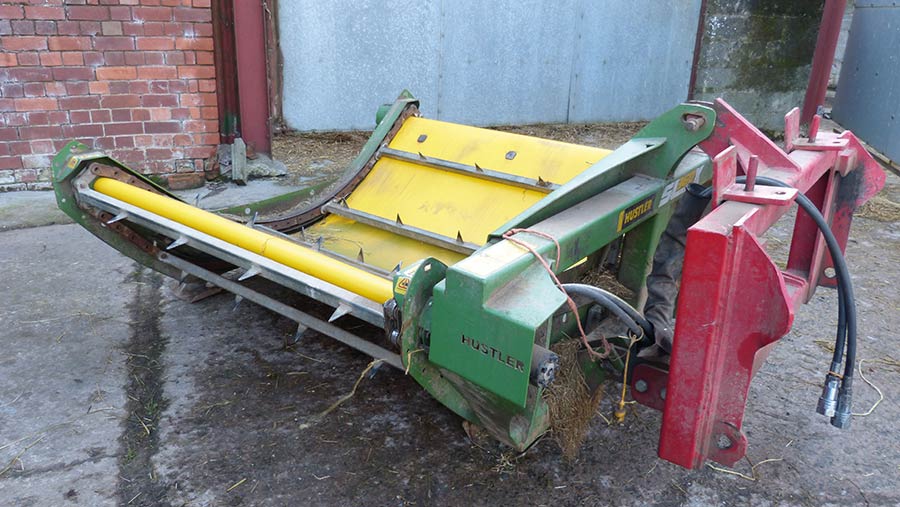Suckler herd saves £100 a calf by focusing on grassland
 © MAG/Michael Priestley
© MAG/Michael Priestley Listen to Michael Priestley read this article or see the text below.
Replacing creep feed with nose flaps and rotational grazing have lifted weaning weights 20% and helped identify the most efficient replacements on a Herefordshire suckler farm.
Commercial suckler farmer Matthew Barnett of Pigeon House Farm, Weston Beggard, near Hereford, used to creep-feed calves from July through to housing in November. But this cost more than £100 a calf and increased workload at one of the busiest times of year.
See also: Hereford herd grows demand with line-bred US genetics
Calves typically started eating more creep in September, coinciding with busy times for the farm’s contract apple harvesting and the cider fruit business overseen by Mr Barnett’s father, Roger.
Mr Barnett also runs a steel-fabricating business with his brother, Russell.
Pigeon House Farm
- Farms 283ha (700 acres) – a mix of owned, rented and tenanted ground
- 15 Speckle Park cows bred pure
- 51 Hereford cows
- 12 Speckle Park-cross Herefords
- Heifers bred to Speckled Park bull for hybrid vigour and meat quality
- 36ha (90 acres) of cider fruit
- 141ha (350 acres) of hay
- 38ha (95 acre) of improved grassland in herbal leys and ryegrass/clover leys
- Calves sold as strong stores at Hereford market
Because Mr Barnett breeds his own replacements, he says creep-feeding was not offering a true reflection of the dams’ or calves’ performance.
“The main reason to stop creeping was that I was kidding myself with weaning weights and heifer replacements. I am trying to cut costs and do more from less,” he says, adding that feeding corn doesn’t help foot health because it promotes horn growth and laminitis.

Matthew Barnett © MAG/Michael Priestley
Cost of creep
The farm fed 19-20t of feed in 2019, which was a combination of rolled oats (sometimes home-grown) and protein pellets.
The cost of £104.25 a calf was based on the market value of the oats and protein pellets and included hiring in someone to mill the oats.
It also covered the cost of a telehandler doing three loads an hour, at £30/hour, up to three times a week.
Remarkably, bull and heifer calf weaning weights have increased since creep-feeding was stopped (see table below).
Weaning weights at Pigeon House Farm |
||
|
Year |
Average weight |
Comments |
|
2018 |
232kg |
Very dry summer |
|
2019 |
221kg |
First year using weaning nose flaps |
|
2020 |
272kg |
Nose flaps and no creep with rotational grazing |
|
2021 |
276kg |
Nose flaps and no creep with rotational grazing |
Grazing changes
Mr Barnett puts higher weaning weights down to a more controlled grazing regime over the past two summers, trying to move cattle after a maximum of seven days, and offering calves fresh grass and clover.
Previously, internal gates were left open, and cattle were left to graze for a month or more.
Achieving a regimented shift pattern is hard because 80% of the farm is rented. Mr Barnett has opportunistically taken on land to expand a hay business.
Some fields are divided in half using solar-powered electric fences. Cows and calves are easy to keep in with one strand of wire and Sunday is now “cattle-moving day” for the Barnetts.

© MAG/Michael Priestley
Better-quality swards at home are rotationally grazed on shorter shifts to make the best use of the herbal leys.
The cattle ground includes large fields on banks and riverside meadows stretching across four main blocks, each with a home-made handling system and crush.
Each block has a bulling group of 12-25 cows allocated to it. There are four groups: heifers, second calvers and two mixed-age cow groups. Bulls are housed briefly after being taken out and rejoin the herd after pregnancy diagnosis.
Quiet wean
Nose flaps have been used since 2019. They are put in place a week to 10 days before the planned weaning day to stop suckling behaviour.
Calves are weighed and nose flaps (costing about £2/flap) are removed at weaning. Cows are either housed or, if conditions allow, grazed out of earshot.
“The calves still bawl, but only for two days rather than five or six,” says Mr Barnett. “We don’t lose nose flaps – we only lost them when using the creep-feeders.”
Calves are kept outside for two weeks after weaning before housing in early December, to get over weaning stress, so there is one less stressor on the animals’ immune systems.
Cost control
Stopping creep-feeding is part of a philosophy that cattle must be challenged to perform off forage.
This is so profitable animals shine in the farm’s system and home-bred replacements continually improve the herd, explains Mr Barnett.
One-third of the herd is typically outwintered until January on deferred grazing. A small herd of 11 cows, calving in September and October, stay out all winter. This year they are on 36ha (90 acres) of deferred grazing after a July hay crop.
“I suspect these could be the lowest-cost and most profitable animals,” says Mr Barnett.
But he stresses the autumn calving block is not a “last-chance saloon” for empty cows. Bulls are taken out after six weeks with heifers, and nine weeks with cows.
As well as having no creep, an experiment outwintering 20 weaned calves on 28ha (70 acres) of deferred grazing is taking place this winter. Mr Barnett hopes to see compensatory growth in the spring.
“I tallied up tractor running costs, my time and the straw a few years ago and it came to £1.10 a cow a day,” he says. “If I can outwinter some and shorten the winter for others, it will help profit.”
Since stopping creep-feeding, the entire system is now based on 100% forage. Spring calvers are housed from mid-November and fed with a New Zealand-built bale unroller, which cost about £5,000.
Large round hay and silage bales are unrolled on alternate days and the cows are given silage four weeks before calving to help them milk. This takes farm staff 10 minutes each day.

A bale unroller was bought second-hand for £5,000 © MAG/Michael Priestley.
Herd future
Mr Barnett started the herd in 2010, when he was given seven cows as payment for building a shed.
Numbers have been expanded from private and dispersal sales, but faltered five years ago when 29 animals were slaughtered due to a TB outbreak.
More recently, the farm has focused more on buying commercially bred, grass-fed genetics.
Nine cows were bought from John Douglas of Ervie Herefords, Stranraer, to tap into genetics imported from a low-intervention, line-bred breeding system in Montana.
Speckle Park embryos have been imported from Canada and bought from Sid Hollier of the Long Ash herd, Dorset.
The farm has also imported grass-fed Hereford embryos from New Zealand.
The next strategy is to cull harder on cow efficiency at weaning time and scrutinise cow weights, as well as calf weights.
Herefords weigh 700-800kg and the Speckled Parks (a composite of Angus, White Park and Shorthorn) average 650kg.
Replacement heifers must be 300kg or more to bull at 15 months, which many now achieve on just milk and grass.
